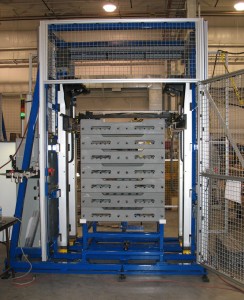Tray Handling

A few weeks ago I covered robots and robotics a bit and it was recently brought to my attention that I hadn’t covered much in the general motion control field. Maybe that’s because most of the applications I have worked on haven’t been particularly challenging from a motion standpoint, most of the time I haven’t worked on anything with true interpolated motion or high speed coordinated moves. Many of my colleagues have though, maybe I can get one of them to cover a particularly challenging application here.
The picture above is an illustration of a non-robotic motion control application I worked on a few years ago. As with most of my other motion jobs, this one didn’t have any kinds of coordinated motion involved, but it was challenging from a sensing standpoint. The concept was to be able to stack (fill) or destack (empty) trays. An operator would load the tray handler with an either full or empty stack of trays with a fork lift. The trays would be presented one at a time to an operator starting either from the bottom or the top of the stack. Much of the coding involved teaching or programming the various stack heights, tray positions and lift points and remembering where you were in the process regardless of what manual activities had taken place.
Two parallel pairs of Z Axes where used to lift the trays. One was the tray lift which would move to the tray above that which was to be removed. It would extend fingers into slots in the trays and then lift the stack off of the target tray. The tray extender would then extend its fingers, lift slightly and a horizontal axis would extend the tray forward to be either filled or emptied by the operator. The two Z axes and the horizontal axis were all Siemens Sinamics servo drives and motors controlled by a Siemens S7-300 PLC. All drive and HMI communications were via Profibus.
The trickiest part of this application was in knowing where the trays were. Since the tray stacks were always full of trays of the same thickness, all of the tray positions were simply programmed as an index value. This saved money from the standpoint of not having to put sensors on the fingers or scan the stack, but it caused some problems when stacks that didn’t conform were inserted. The trays and spacer poles were made of graphite, a brittle ceramic material that could withstand high oven temperatures; as such they were quite breakable. A few photoeyes were located in the machine for product location but they didn’t always work where trays were mis-oriented.
Overtravel switches were located in the usual locations near the ends of the axes, but ideally they would have been put on the vertical axes tooling mounts themselves since the axes could hit each other long before they reached end of stroke. This is a good thing to remember whenever working with two parallel axes that can interfere with each other, always take into account what else the axis can hit besides end of travel on the actuator itself.
If anyone has any good motion control applications or technical information they would like to share please send it to me. I have yet to have any guest posts in nearly a year since I started this site and I’d love to hear input from someone with good motion experience.
